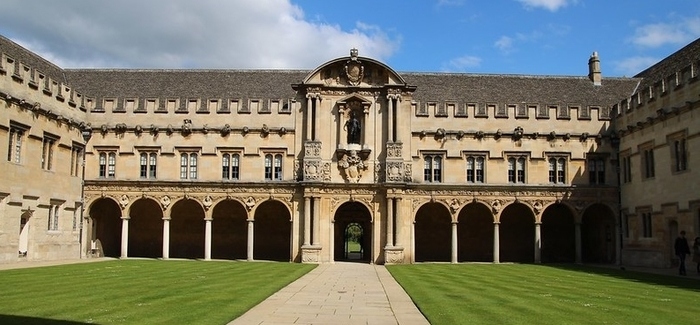作为英国历史最悠久、最著名的大学,牛津大学和剑桥大学的竞争历史可以追溯到 800 多年前。 “牛津剑桥”的两部分可能有许多共同点——寄宿学院、基于辅导的教学、数百年的传统——但正如任何牛津或剑桥的毕业生都会告诉你的那样,这就是相似之处的终结。
在选择申请哪所大学时,通过英国大学和学院招生服务 (UCAS) 的申请者只能选择牛津和剑桥中的一所,因此做出正确的决定至关重要。
那么,你会选择哪一个呢?
|
|
牛津大学 |
剑桥大学 |
|
2020年QS世界大学排名 |
全球排名第4
学术界和毕业生雇主排名世界第3
教员/学生比例排名第8
研究影响排名45(每位教师的引用次数)
国际教师比例排名64,国际学生比例排名50
|
全球排名第7
学术界排名全球第2,雇主排名全球第2
教员/学生比例排名第10
研究影响排名74(每位教师的引用次数)
国际学生和国际教师的比例均排58
|
|
学科优势 基于学科广泛的2019年QS世界大学学科排名 |
38门学科名列世界前茅; 其中只有3项没有进入前 10 名,其他均位于前十。
人类学、考古学、英语语言文学、地理和药学世界第一。
|
39门学科名列世界前茅;其中只有1项没有进入前 10 名,其他均位于前十。
解剖学世界第一,人类学、考古学、英语、历史和现代语言均第二。 |
|
地理位置 |
伦敦西北约 60 英里(乘火车约一小时)
一般认为比较有活力 |
伦敦以北约 60 英里(乘火车不到一小时)
一般觉得景色更美 |
|
学费 |
英国/欧盟本科生每年 9,250 英镑(约 10,760 欧元)
非欧盟本科生每年 24,750 - 34,678 英镑(约 32,800-45,900 美元)(不包括医学;加上 2019 年入学的大学费用)
不同的研究生学位费用不同(见下文) |
英国/欧盟本科生每年 9,250 英镑(约 10,760 欧元)
2019 年开始学习的非欧盟本科生(不包括医学)每年 19,197 英镑至 30,678 英镑(约合 25,420 美元至 40,620 美元)。
不同的研究生学位费用不同(见下文)
|
|
资金支持 |
为英国/欧盟本科生提供学费贷款
为国内外学生提供广泛的奖学金和助学金 |
为英国/欧盟本科生提供学费贷款
为国内外学生提供广泛的奖学金和助学金 |
2020年QS 世界大学排名®
牛津大学在 2020 年 QS 世界大学排名® 中的排名高于剑桥,但仅略胜一筹。重要的是要记住,在这个级别上,机构之间的差异通常很小——作为全球前 10 名的长期成员,牛津和剑桥都在世界高等教育精英中站稳了脚跟。
牛剑品牌非常强大,在 QS 对学者和雇主的国际调查中,两所学校都获得了很高的评价。在最新的结果中,剑桥在学术和雇主方面均位居世界第二。与此同时,牛津大学在毕业生雇主和学者的评价中排名世界第三。简而言之:如果你想在一所享有良好国际声誉的大学学习,牛津或剑桥的学位很难被击败。
牛津的每位教员的引用分数略高——该指标旨在反映每个机构的研究所获得的影响力——尽管剑桥也不甘落后。牛津在师生比例(每名学术人员的学生人数)方面也处于领先地位,但两者都在全球前 10 名之内,并以其对小组教学和个人监督的承诺而闻名。
在国际多样性方面,牛津和剑桥再次获得高分。毫不奇怪,两者都是来自世界各地的学者和学生的热门目的地。尽管最近有人批评其缺乏多样性,但牛津在其国际学生比例方面仍处于领先地位,尽管剑桥在其国际教师比例方面的得分略高。
学科优势
看看 QS 世界大学学科排名,可以确认牛津和剑桥在各个领域都处于世界领先地位。在最新一期中,牛津大学在可能的 48 门学科中总共有 38 门进入了学科排名,而剑桥大学则出现了 39 门。正如您在下表中看到的,两所大学的绝大多数学科都名列前 10 名。
|
2019年QS世界大学各学科排名中的牛津大学和剑桥大学 |
||
|
|
牛津大学 |
剑桥大学 |
|
会计与财务 |
4 |
8 |
|
农林业 |
2 |
1 |
|
人类学 |
1 |
2 |
|
考古学 |
1 |
2 |
|
建筑学 |
-- |
7 |
|
艺术设计 |
37 |
-- |
|
生物科学 |
4 |
3 |
|
商业和管理 |
10 |
7 |
|
化学 |
6 |
并列第3 |
|
古典和传统历史 |
2 |
3 |
|
计算机科学和信息系统 |
6 |
5 |
|
发展研究 |
3 |
5 |
|
地球和海洋科学 |
5 |
4 |
|
经济学 |
9 |
10 |
|
教育和培训 |
4 |
5 |
|
(化学)工程 |
6 |
并列第3 |
|
(土木)工程 |
16 |
5 |
|
(电气)工程 |
11 |
5 |
|
(机械)工程 |
并列第8 |
3 |
|
英语语言文学 |
1 |
2 |
|
环境科学 |
6 |
8 |
|
地理 |
1 |
3 |
|
历史 |
3 |
2 |
|
法律 |
2 |
3 |
|
语言学 |
9 |
6 |
|
数学 |
6 |
5 |
|
材料科学 |
并列第7 |
4 |
|
医学 |
2 |
3 |
|
现代语言 |
3 |
2 |
|
表演艺术 |
并列第9 |
11 |
|
药学 |
4 |
6 |
|
哲学 |
4 |
6 |
|
物理学和航天 |
6 |
4 |
|
政治学 |
2 |
5 |
|
心理学 |
3 |
4 |
|
社会政策和管理 |
3 |
4 |
|
社会学 |
2 |
并列第6 |
|
数据学 |
7 |
5 |
|
理论、神学和宗教研究 |
3 |
4 |
|
兽医学 |
-- |
4 |
地点
牛津在一般来说是一个城市,剑桥是一个城镇,但实际上两者都是相对较小和紧凑的居住地,步行或骑自行车(很受欢迎)很容易导航。
它们风景如画,都以迷人的历史建筑和流经市中心的河流为特色,在那里您会发现学生正在接受校际赛艇比赛或一年一度的牛津-剑桥赛艇比赛的训练。后者可能是每年牛津剑桥竞争最激烈的一天。 牛津和剑桥也都靠近英国首都。伦敦距牛津约一小时火车车程,距剑桥不到一小时车程。就这两个地点之间的差异而言,人们普遍认为剑桥更漂亮一些,而牛津的情况要多一些——但这当然可能取决于你问的是谁。
费用和生活费
牛津和剑桥都根据学生是否来自欧盟内部收取不同的学费。英国脱欧公投的结果意味着欧盟学生可能会担心他们的学费是否会在课程期间增加。但是,英国政府已经确认,在读学生和 2019 学年录取的学生将在其课程期间继续支付当前的国内/欧盟费率。
下表粗略概述了您每年可以为全日制课程支付的费用,具体取决于您的学习水平和国籍。查看大学网站以了解确切的费率,并记住,研究生课程和非欧盟学生本科课程的收费金额因学科而异。
|
牛津大学和剑桥大学 (2019/20全日制) 学生每年的学费 |
||
|
|
牛津大学
|
剑桥大学
|
|
(英国/欧盟)本科生 |
9,250英镑 (约合10,760欧元)
|
9,250英镑
|
|
(非欧盟)本科生 |
每年24,750-34,678英镑 大多数课程 (约合32,800-45,900美元)。 |
19,197-30,678英镑 大多数课程(约合25,420- 40,620美元) ; 兽医和医学课程52,638英镑(约合69,700美元) |
|
(英国/欧盟)研究生 |
7,730-17,745英镑大多数硕士和博士项目 (约合9,000-20,640欧元) ; 学科不同学费也不同; 还有几项学科学费较高. |
8,337-16,320英镑大多数硕士和博士项目 (约合9,700-19,000欧元) ; 学科不同学费也不同 |
|
(非欧盟)本科生 |
大多数硕士和博士项目 22,600-26,960英镑(约合29,930 -35,700美元) ; 学科不同学费也不同; 还有几项学科学费较高. |
大多数硕士和博士项目 20,424-29,343英镑 (约合27,050-38,860美元) ; 学科不同学费也不同; 还有几项学科学费较高. |
海外学生还将被收取额外的“大学费用”,这也适用于未就读第一个公共资助学位的英国/欧盟学生。
目前,剑桥的海外本科生每年需要 7,116 英镑到 9,500 英镑(取决于学院),牛津大学的海外本科生每年需要 7,570 英镑。
除课程费用外,牛津大学建议学生每年支付 12,168 至 18,655 英镑(约 16,120-24,700 美元)的生活费用,包括住宿、食物、学习资源、社交和其他项目。
剑桥建议每年至少支付 10,950 英镑(约 14,500 美元)的生活费。 你可以在这里找到更多关于在英国学习的费用。
经济支持
总体而言,在牛津或剑桥学习的费用加起来了,尽管它仍然低于美国大多数顶尖大学的学位预付费用。对于许多学生来说,需要某种形式的经济支持。
来自英国境内和其他欧盟国家的本科生可以以学生贷款的形式向英国政府申请财政支持。这些包括学费,免息,并在学生开始工作并开始赚取一定金额后逐渐偿还(计划 2 毕业生的还款门槛目前为 25,000 英镑)。全日制本科水平的英国学生还可以申请额外的贷款和助学金,以帮助支付生活费用。
牛津和剑桥都提供一系列奖学金和财政支持计划。在剑桥,英国和欧盟的本科生每年可以申请的助学金高达 3,500 英镑,此外还有一系列向不同背景的学生开放的资助机会。牛津的网站允许学生根据他们的课程和国籍搜索他们可能有资格获得的任何奖学金。
两所大学所在的各个学院也提供奖学金和助学金。当然,在牛津或剑桥学习的奖学金是世界上最具竞争力的奖学金之一——就像获得入学一样。但是,如果您的申请成功,您可能会获得一种既具有学术挑战性又具有美学启发性的体验。
本文最初于 2013 年 10 月发布。最后更新于 2019 年 6 月。 Sabrina Collier 的补充报道。
想要更多这样的内容吗?注册免费网站会员以获取定期更新和您自己的个人内容提要。

















